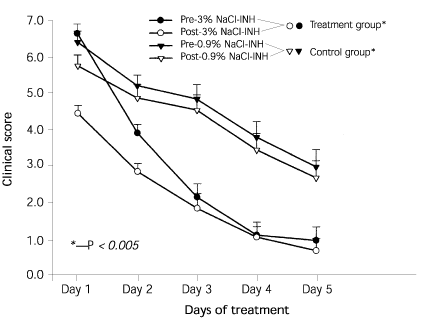
Am Fam Physician. 2003;67(7):1612-1614
Bronchiolitis is a disease that is prevalent in children. The most common etiologic agent is respiratory syncytial virus (RSV). The underlying pathology that creates the symptoms of this viral illness is edema of the small airways, which is a secondary response to RSV infection. This edema leads to hyperinflation and atelectasis of the lungs, and wheezing. Despite multiple attempts to treat this infection, there have been few advances in reducing the symptoms that develop with bronchiolitis. One possible solution is to use hypertonic saline delivered by nebulizer to reduce the edema and improve the clearance of thick mucous plaques in the small airways. Sarrell and associates evaluated the use of inhaled hypertonic saline solution in the treatment of bronchiolitis in ambulatory infants.

The study was a randomized, double-blind, controlled trial of ambulatory infants with acute bronchiolitis. The participants were infants up to 24 months of age who presented to an ambulatory pediatric center with mild to moderate bronchiolitis. The participants were randomized to receive 0.5 mL (5 mg) terbutaline in 2 mL of 0.9 percent saline solution as a wet nebulized aerosol or 0.5 mL (5 mg) terbutaline in 2 mL of 3 percent saline solution administered in the same manner. The treatment was repeated three times a day for five days. Patients were examined before the study and every morning during the treatment phase, before and 30 minutes after the treatment. The infants were assessed using a published clinical severity score at each visit, and on days 1 and 3, chest radiographs were obtained. The radiographs also were interpreted using a published scoring system. The physician examining the patients was blinded as to which nebulizer therapy the infants were receiving.
The clinical severity scores were equal in the treatment groups at the start of the study. On the first day, the group treated with hypertonic saline and nebulized terbutaline had a significantly lower clinical severity score than those receiving the 0.9 percent saline-based treatment. This significant improvement in clinical severity scores persisted through the remainder of the study (see accompanying figure). There was no difference in hospitalization rates between the two groups, but because hospitalization was a rare event in the study population, it would require a much larger sample to determine if the different interventions had any impact on this variable. In addition, there was no significant difference in radiologic assessment scores between the two groups. No adverse events were reported in either of the groups.
The authors conclude that hypertonic saline plus terbutaline is effective in decreasing symptoms when compared with 0.9 percent saline in the treatment of nonasthmatic, mild bronchiolitis in infants. The hypertonic treatment also had an excellent safety profile when compared with the normal saline treatment.